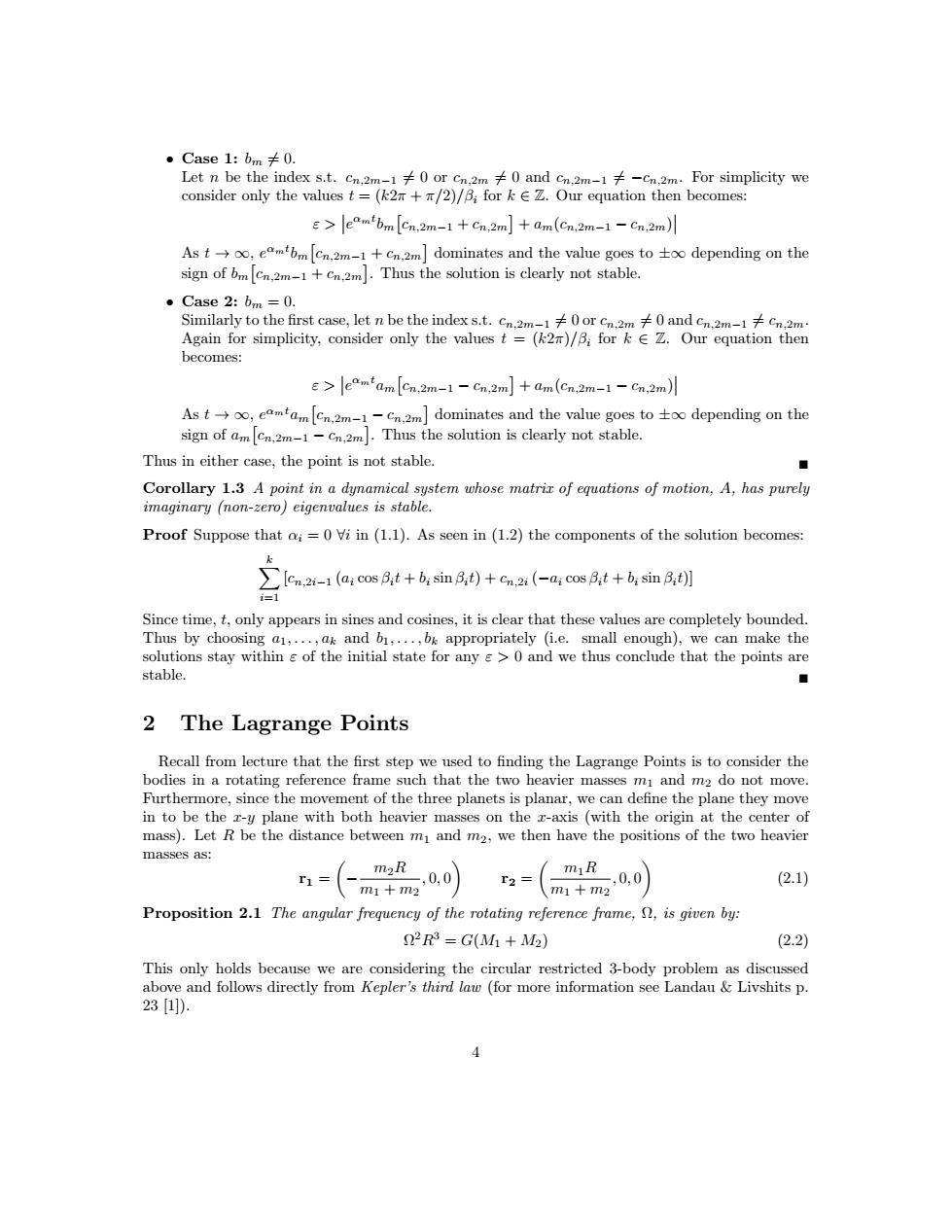正在加载图片...

·Case1:bm≠0. Let n be the index s.t.cn,2m-1≠0orcm,2m≠0 and cn,2m-1≠-cn,2m·For simplicity we consider only the values t=(k2+/2)/B;for k EZ.Our equation then becomes: eamtbm[cn.2m-1+cn.2m]am(cn.2m-1-Cn.2m) As temm[cn.2m-1+cn.2m]dominates and the value goes to oo depending on the sign of bm Cn.2m-1+cn.2m.Thus the solution is clearly not stable. ·Case2:bm=0. Similarly to the first case,let n be the index s.t.cn.2m-10or cn.2m0and cn.2m-1Cn.2m. Again for simplicity,consider only the values t =(k2m)/B;for k EZ.Our equation then becomes: e>eamtam[cn.2m-1-cn.2m]+am(cn.2m-1-cn.2m) Astt[Cn.2m-1-cn.2m]dominates and the value goes to depending on the sign of am Cn.2m-1-cn.2m.Thus the solution is clearly not stable. Thus in either case,the point is not stable. ◆ Corollary 1.3 A point in a dynamical system whose matrix of equations of motion,A,has purely imaginary (non-zero)eigenvalues is stable. Proof Suppose that ai=0 Vi in(1.1).As seen in(1.2)the components of the solution becomes: lcn2i-1(a:cos月t+b:sin,t)+cn.2i(-a:cos3,t+bsin3,t切 i=1 Since time,t,only appears in sines and cosines,it is clear that these values are completely bounded. Thus by choosing a1,...,ak and bi,...,bk appropriately (i.e.small enough),we can make the solutions stay within e of the initial state for any s>0 and we thus conclude that the points are stable. ◆ 2 The Lagrange Points Recall from lecture that the first step we used to finding the Lagrange Points is to consider the bodies in a rotating reference frame such that the two heavier masses mi and m2 do not move. Furthermore,since the movement of the three planets is planar,we can define the plane they move in to be the z-y plane with both heavier masses on the z-axis(with the origin at the center of mass).Let R be the distance between m and m2,we then have the positions of the two heavier masses as: r1= m2R ,0,0 miR r2= -,0,0 (2.1) m1+m2 m1+m2 Proposition 2.1 The angular frequency of the rotating reference frame,S,is given by: 22R3=G(M1+M2) (2.2) This only holds because we are considering the circular restricted 3-body problem as discussed above and follows directly from Kepler's third law(for more information see Landau Livshits p. 231]).• Case 1: bm 6= 0. Let n be the index s.t. cn,2m−1 6= 0 or cn,2m 6= 0 and cn,2m−1 6= −cn,2m. For simplicity we consider only the values t = (k2π + π/2)/βi for k ∈ Z. Our equation then becomes: ε >
e αmt bm cn,2m−1 + cn,2m + am(cn,2m−1 − cn,2m)
As t → ∞, e αmt bm cn,2m−1 + cn,2m dominates and the value goes to ±∞ depending on the sign of bm cn,2m−1 + cn,2m . Thus the solution is clearly not stable. • Case 2: bm = 0. Similarly to the first case, let n be the index s.t. cn,2m−1 6= 0 or cn,2m 6= 0 and cn,2m−1 6= cn,2m. Again for simplicity, consider only the values t = (k2π)/βi for k ∈ Z. Our equation then becomes: ε >
e αmt am cn,2m−1 − cn,2m + am(cn,2m−1 − cn,2m)
As t → ∞, e αmtam cn,2m−1 − cn,2m dominates and the value goes to ±∞ depending on the sign of am cn,2m−1 − cn,2m . Thus the solution is clearly not stable. Thus in either case, the point is not stable. . Corollary 1.3 A point in a dynamical system whose matrix of equations of motion, A, has purely imaginary (non-zero) eigenvalues is stable. Proof Suppose that αi = 0 ∀i in (1.1). As seen in (1.2) the components of the solution becomes: X k i=1 [cn,2i−1 (ai cos βit + bi sin βit) + cn,2i (−ai cos βit + bi sin βit)] Since time, t, only appears in sines and cosines, it is clear that these values are completely bounded. Thus by choosing a1, . . . , ak and b1, . . . , bk appropriately (i.e. small enough), we can make the solutions stay within ε of the initial state for any ε > 0 and we thus conclude that the points are stable. . 2 The Lagrange Points Recall from lecture that the first step we used to finding the Lagrange Points is to consider the bodies in a rotating reference frame such that the two heavier masses m1 and m2 do not move. Furthermore, since the movement of the three planets is planar, we can define the plane they move in to be the x-y plane with both heavier masses on the x-axis (with the origin at the center of mass). Let R be the distance between m1 and m2, we then have the positions of the two heavier masses as: r1 = − m2R m1 + m2 , 0, 0 r2 = m1R m1 + m2 , 0, 0 (2.1) Proposition 2.1 The angular frequency of the rotating reference frame, Ω, is given by: Ω 2R 3 = G(M1 + M2) (2.2) This only holds because we are considering the circular restricted 3-body problem as discussed above and follows directly from Kepler’s third law (for more information see Landau & Livshits p. 23 [1]). 4������������